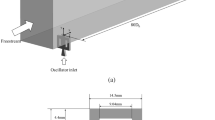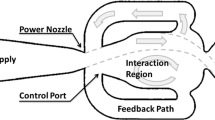Abstract
A numerical investigation of a fluidic oscillator was performed to understand the unsteady internal flow field and geometrical effects on the performance using three-dimensional unsteady Reynolds-averaged Navier-Stokes equations. Effects of the two geometrical parameters, i.e., the inlet width of the mixing chamber and outlet throat width, on peak jet velocity ratio at the exit and pressure drop through the oscillator, were evaluated. The unsteady simulation was performed using shear stress transport turbulence model with air as working fluid at Reynolds number 30000. Computational results showed good qualitative and quantitative agreements with available experimental results for the flow structure and frequency of the oscillating jet. Results of the parametric study suggested that the inlet width affected significantly the flow in the fluidic oscillator, while effects of the throat width on the performance parameters were not remarkable.
Similar content being viewed by others
References
L. N. Cattafesa III, N. Louis and M. Sheplak, Actuators for active flow control, Annual Review of Fluid Mechanic, 43 (2011) 247–272.
V. Tesar, S. Zhong and F. Rashed, New fluidic-oscillator concept for flow-seperation control, AIAA Journal (2013).
J. W. Gregory and M. N. Tomac, A review of fluidic oscillator development and application for flow control, AIAA Paper, 2474 (2013).
T. Vaclav, High-frequency fluidic oscillator, Sensors and Actuators A: Physical, 234 (2015) 158–167.
V. Vasta, M. Koklu and I. Wygnanski, Numerical simulation of fluidic actuators for flow control applications, 6th AIAA Flow control Conference (2012).
G. Raman and S. Raghu, Cavity resonance suppression using miniature fluidic oscillators, AIAA Paper (2012) 2608–2612.
R. Seele, P. Tewes, R. Woszidlo, M. A. McVeigh, J. N. Lucas and I. J. Wygnanski, Discrete sweeping jets as tools for improving the performance of the V-22, Journal of Aircraft, 46 (6) (2009) 2098.
L. Taubert and I. Wygnanski, Preliminary experiments applying active flow control toa 1/24th scale model of a semi-trailer truck, The Aerodynamics of Heavy Vehicles II: Trucks, Buses and Trains (2009) 105–113.
C. Cerretelli, W. Wuerz and E. Gharaibah, Unsteady separation control on wind turbines using fluidic oscillators, AIAA Journal, USA (2010) 1302–1311.
G. H. H. Kim, A study of fluidic oscillators as an alternative pulsed vortex generating jet actuator for flow separation control, Dissertation (2012).
D. Greenblatt and I. J. Wygnanski, The control of flow separation by periodic excitation, Progress in Aerospace Sciences, Seven Ed. (2000) 487–545.
C. Cerretelli and K. Kirtley, Boundary layer separation control with fluidic oscillators, Journal of Turbomachinery, 131 (4) (2009) 041001.
D. You and P. Moin, Active control of flow separation over an airfoil using synthetic jets, Journal of Fluids and Strucutes, 24 (8) (2008) 1349–1357.
R. Seele, E. Graff, J. Lin and I. Wygnanski, Performance Enhancement of a vertical tail model with sweeping actuators, AIAA Paper, 411 (2013) 1349–1357.
R. Woszidlo and I. Wygnanski, Parameters governing separation control with sweeping jet actuators, Dissertation (2011).
J. T. Yang, C. K. Chen, K. J. Tsai, W. Z. Lin and H. J. Sheen, A novel fluidic oscillator incorporating step-shaped attachment walls, Sensors and Actuators A: Physical, 135 (2) (2007) 476–483.
C. Xu and X. Meng, Performance characteristic curve insensitive to feedback fluidic oscillator configurations, Sensors and Actuators A: Physical, 189 (2013) 55–60.
O. Kruger, B. C. Woszildo, R. Woszildlo and C. O. Paschereit, Numeical modeling and validation of the flow in a fluidic oscillator, 21st AIAA Computational Fluid Dynamics Conference, Reston, Virginia, USA (2013).
F. Ostermann, R. Woszidlo, R. Nayeri and C. O. Paschereit, Experimental comparison between the flow field of two common fluidic oscillators design, 53rd AIAA Aerospace Science Meeting, AIAA Scitech (2015).
B. C. Bobusch, R. Woszidlo, J. M. Bergada, C. N. Nayeri and C. O. Paschereit, Experimental study of the internal flow structures inside a fluidic oscillator, Experiments in Fluids, 54 (6) (2013) 1559.
B. C. Bobusch, R. Woszidlo, R. Kruger and C. O. Paschereit, Numerical investigations on geometric parameters affecting the oscillation properties of a fluidic oscillator, 21st AIAA Computational Fluid Dynamics Conference (2013).
S. A. Gokoglu, A. Suleyman, M. A. Kuczmarksi, D. E. Culley and S. Raghu, Numerical studies of a fluidic diverter for flow control, 39th AIAA Fluid Dynamics Conference (2009) 1–14.
Author information
Authors and Affiliations
Corresponding author
Additional information
This paper was presented at the ICCHM2T2017, Sejong Hotel, Seoul, Korea, May 28–June 1, 2017. Recommended by Guest Editor Heuy Dong Kim.
Raunak Jung Pandey received his bachelor’s degree in mechanical engineering from Kathmandu University in 2014. He is currently pursuing his research toward M.S. degree in thermodynamics and Fluid Mechanics at Inha University. His research interest is in fluidic oscillator.
Kwang-Yong Kim received his B.S. degree from Seoul National University in 1978, and his M.S. and Ph.D. degrees from the Korea Advanced Institute of Science and Technology (KAIST), Korea, in 1981 and 1987, respectively. He is currently a Dean of Engineering College and a Professor in the Department of Mechanical Engineering of Inha University, Incheon, Korea. Professor Kim is also the current Editor-in-Chief of the International Journal of Fluid Machinery and Systems, the Associate Editor of ASME Journal of Fluids Engineering, and the Chairman of the Asian Fluid Machinery Committee. He served as the Editor-in-Chief of the Transactions of Korean Society of Mechanical Engineers and President of Korean Society for Fluid Machinery. He is also a fellow of the Korean Academy of Science and Technology, a fellow of the American Society of Mechanical Engineers (ASME), an associate fellow of the American Institute of Aeronautics and Astronautics (AIAA), and a recipient of order of science and technology merit, “Doyak medal” from Republic of Korea.
Rights and permissions
About this article
Cite this article
Pandey, R.J., Kim, KY. Numerical modeling of internal flow in a fluidic oscillator. J Mech Sci Technol 32, 1041–1048 (2018). https://doi.org/10.1007/s12206-018-0205-x
Received:
Revised:
Accepted:
Published:
Issue Date:
DOI: https://doi.org/10.1007/s12206-018-0205-x




